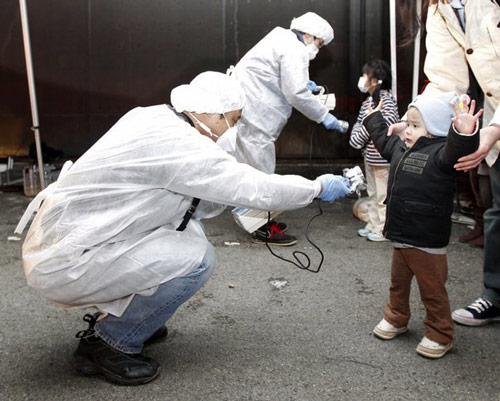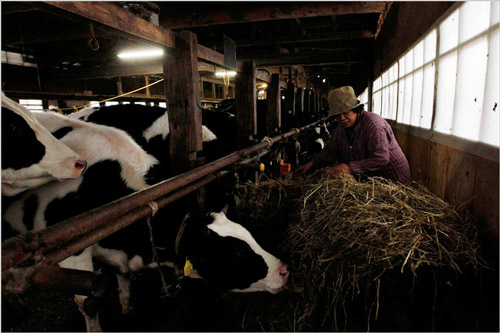Contamination and health controls in Japan

Contamination controls on a child
Radiation protection technicians checking for the presence of radioactive contamination on this little boy evacuated from the area around the Fukushima power station. Contrarily to what happened in Chernobyl, Japanese authorities took the necessary precautions at very early stages. The most essential was to avoid ingestion or inhalation of radioactive material, internal exposure being by far the most dangerous.
© Asahi Shimbun, via Reuters
The health impacts of the accident primarily concerned Japan. In the other countries, they have been much smaller or negligible in America and Europe.
In Japan, contaminations have mainly affected the vicinity of the plant, the northwest of the country, the prefectures around Fukushima and to a lesser extent Tokyo and its millions of inhabitants. For a good radioprotection, it is necessary to avoid internal exposure, the most dangerous : the control of water and food are essential.
In the first few weeks after the accident, the main contamination requiring protection was that of iodine-131, which disappeared in a few weeks, but which get into the food chain through leafy vegetables and milk. On Tuesday, March 22, the announcement in downtown Tokyo of levels of iodine-131 of 210 becquerels per liter of water had been detected (twice the threshold of 100 recommended for babies) caused emotion. This anomaly lasted 24 hours.

Iodine-131 and milk contamination
A farm in Fukushima Prefecture, 50 km west of the damaged plant. On March 19th 2011, authorities reported levels of radioactivity above the authorized thresholds measured in milk and spinach coming from farms close to the nuclear plant. Spinach leaves and grass grazed by cows were contaminated with radioactive iodine fallout. In polluted area, cows were fed with uncontaminated hay.
© Ken Shimizu/Agence France-Presse – Getty Image
Three months after the accident, three types of food still showed significant contamination with cesium 134 and 137, occasionally exceeding the maximum allowable levels : bamboo shoots, green tea leaves and apricots from Japan.
After the Chernobyl accident, it was found that the cesium contamination of food by cesium, initially due to radioactive deposits on leaves and grass, decreased with time much faster than the radioactive decay : from the first regrowth after the accident, the direct leaves and grass cesium uptake cesium is replaced by a much less less efficient uptake via the roots. A similar evolution took place in Japan: among the 10 million bags of rice produced in 2012 on the decontaminated sites of Fukushima Prefecture, only 71 exceeded the radioprotection standard limits.
Six years after the accident, the radioactivity of the agricultural productions of the concerned territories are well below the tsafety hresholds, with rare exceptions (certain mushrooms for example). The same is true for running fishing, but the fishing in the sedimentary seabed near the damaged plant remains prohibited because of the fixation of cesium in the sediments.
For the all various foods monitored since 2011 (cereals, fruits and vegetables, meat, milk …), the total contamination rates have decreased to a negligible level, making their consumption possible. All results showed levels below the limit of 100 becquerels per kilo set by the Japanese authorities.

Dose evaluation of a contaminated rice
In October 2011, news media reported a sample of rice harvested in the Fukushima region whose 0.5 kBq/kg activity exceeded 5 times the legal dose. The calculation of the dose resulting from the ingestion of this contaminated rice (using the table of the dose factors) shows that the ingested dose was very low. Legal limits are cautious. There was no reason to worry but vigilance was useful.
© IN2P3
Risks of cancers ?
The amount of radioactivity exposures to which the vast majority of the population in Japan has been exposed belong to a dose range called by radioprotectionists the « low dose » domain. Radiobiologists do not know whether or not radiation in this range induces cancer. Because of this lack of knowledge and in the name of the precautionary principle, radioprotection assumes that there is a risk. To calculate the number of cancers resulting from an exposure, they use a rule called the Linear No-threshold Model
The regulatory limit of 1 millisievert (mSv) excludes the most common exposures: natural radioactivity and medical examinations. A frequent examination like a scanner goes far beyond it. By applying the precautionary principle, the limit of exposures excluding natural radioactivity and medical examinations has been set to this very low 1 mSv level. The corresponding risk is accordingly very low and should not be a source of anxiety.
It is still too early to know if possible cancers will apperwithin a few years. A parallel with Chernobyl is however not justified. According to a survey of people living in Fukushima Prefecture at the time of the accident, only 15 had received more than 15 mSv during the first 4 months of the 564,083 respondents to the survey. Releases were lower aat Fukushima. Above all, unlike the case of the former USSR in 1986, precautions were taken in time by the authorities (sheltering populations, strict food controls). A large-scale epidemiological study was launched in 2011 to study the effects of low-dose radiation on residents of Fukushima Prefecture. More than 2 million people will be medically followed for thirty years!
Cancers of the thyroïd ?
Around Chernobyl, numerous thyroid cancers have been observed among children and adolescents. The authorities have been slow to take appropriate measures. In Japan, people have had time to be sheltered and food was controlled during the most critical earliest days. A similar epidemic did not appear 6 years later. Thyroid examinations (ultrasound, then biopsy in case of anomaly), have been made since the accident on children then aged 0 to 18 years, or 367,707 people. Major testing campaigns are conducted every two years to see if there may be an increase in cases.
The first campaign resulted in the detection of a cancerous tumor removed in the case 98 children. This number is close to the expected thyroid cancers of natural causes observed from similar campaigns in the Japanese prefectures (Aomori, Yamanashi …) not affected by the fallout and showing incidences between 23 and 130 per 100,000. There is therefore up to now no link between the fallout and the incidence of thyroid cancers.
A study on social consequences of the 3/11 nuclear accident in Fukushima prefecture (IRSN 2019)
Other articles on the subject « Fukushima accident »
Fukushima : Events and Causes
March 11th 2011 : cascade of unlikely accidents … The earthquake The magnitude 9 earthquake[...]
Fukushima : Contaminations
Atmospheric releases and map of ground déposits The contaminations due to Fukushima radioactive r[...]
Fukushima decontamination
2014 -2017: Status of clean-up operations The major clean-up program of contaminated areas in Jap[...]
Fukushima today
A long way from reactors cold shutdown to their dismantling .. Today, 8 years after the accident,[...]